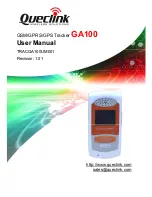
Chapter 4 Command Listing and Status Information
Z3801A Commands
4-8
User’s Guide
[SOURce]:PTIMe (Cont.)
:LEAPsecond
:ACCumulated?
returns INT
Identifies accumulated time difference (in
seconds) between GPS and UTC time scales.
:GPSTime?
returns INT in HEX
GPS time of next pending leapsecond.
:SYNChronization
Node Only.
:IMMediate
Used during recovery to initiate a near
instantaneous alignment of GPS
1 PPS and Receiver output 1 PPS.
:TCODe:FORMat
F1 | F2
Selects or queries the format of the time code
message returned by :PTIM:TCOD?
:TCODe?
returns quoted string
Provides timecode message 980 to 20 ms prior to
1 PPS of indicated time. Format is specified by
:PTIM:TCOD:FORMat. Type of data provided:
time in secs of next on-time edge, TFOM, leapsec
data, alarm indication, and service request.
See “Detailed Description of the Two Time Code
Formats” on page 4-12 for complete information.
:TINTerval?
returns REAL in seconds
Returns the filtered GPS 1 PPS to internal
oscillator 1 PPS interval. Generates an error
(
−
230, Data corrupt or stale
) when this interval
is unavailable (e.g., if no GPS 1 PPS or no
satellites available).
[SOURce]:ROSCillator
Node Only. (
Note: [SOURCe]:SYNChronization
is an alias for [SOURCe]:ROSCillator.)
:HOLDover
Node Only
:DURation?
returns REAL in seconds,
0 | 1
First parameter is amount of time that Receiver
has been in current holdover or amount of time of
last holdover, depending on holdover state.
Second parameter identifies holdover state: 0 =
not in holdover, 1 = in holdover.
:INITiate
Places the Receiver in holdover. It will stay there
until you send :ROSC:HOLD:REC:INITiate.
:RECovery
Node Only
:INITiate
Initiates a recovery from holdover. Use this
command to take the Receiver out of a manually
selected holdover. It is not used to initiate
holdover recovery in any other situation.
Table 4-2. Z3801A PRIMARY Commands (continued)
Keyword/Syntax
Parameters/
Responses
Comments
Summary of Contents for Z3801A
Page 6: ...Contents vi User Guide ...
Page 12: ...In This Guide xii User Guide ...
Page 13: ...1 Getting Started ...
Page 30: ...Chapter 1 Getting Started Using Commands to Control Key Functions Examples 1 18 User Guide ...
Page 31: ...2 Features and Functions ...
Page 44: ...Chapter 2 Features and Functions In Case of a Problem 2 14 User Guide ...
Page 45: ...3 Using the Receiver Status Screen ...
Page 63: ...Chapter 3 Using the Receiver Status Screen Receiver Status Screen Data User Guide 3 19 ...
Page 67: ...4 Command Listing and Status Information ...
Page 90: ...Chapter 4 Command Listing and Status Information Error Messages 4 24 User s Guide ...
Page 91: ...5 Specifications Summary ...
Page 98: ...Index Index 4 User Guide wiring dc power input 1 5 ...















































